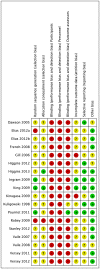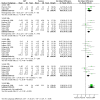Contrast water therapy and exercise induced muscle damage: a systematic review and meta-analysis
- PMID: 23626806
- PMCID: PMC3633882
- DOI: 10.1371/journal.pone.0062356
Contrast water therapy and exercise induced muscle damage: a systematic review and meta-analysis
Abstract
The aim of this systematic review was to examine the effect of Contrast Water Therapy (CWT) on recovery following exercise induced muscle damage. Controlled trials were identified from computerized literature searching and citation tracking performed up to February 2013. Eighteen trials met the inclusion criteria; all had a high risk of bias. Pooled data from 13 studies showed that CWT resulted in significantly greater improvements in muscle soreness at the five follow-up time points (<6, 24, 48, 72 and 96 hours) in comparison to passive recovery. Pooled data also showed that CWT significantly reduced muscle strength loss at each follow-up time (<6, 24, 48, 72 and 96 hours) in comparison to passive recovery. Despite comparing CWT to a large number of other recovery interventions, including cold water immersion, warm water immersion, compression, active recovery and stretching, there was little evidence for a superior treatment intervention. The current evidence base shows that CWT is superior to using passive recovery or rest after exercise; the magnitudes of these effects may be most relevant to an elite sporting population. There seems to be little difference in recovery outcome between CWT and other popular recovery interventions.
Conflict of interest statement
Figures






References
-
- Leeder J, Gissane C, van Someren K, Gregson W, Howatson G (2012) Cold water immersion and recovery from strenuous exercise: a meta-analysis. Br J Sports Med 46: 233–240. - PubMed
-
- Cheung K, Hume P, Maxwell L (2003) Delayed onset muscle soreness : treatment strategies and performance factors. Sports Med 33: 145–164. - PubMed
-
- Friden J, Sjostrom M, Ekblom B (1983) Myofibrillar damage following intense eccentric exercise in man. Int J Sports Med 4: 170–176. - PubMed
-
- Howatson G, van Someren KA (2008) The prevention and treatment of exercise-induced muscle damage. Sports Med 38: 483–503. - PubMed
Publication types
MeSH terms
LinkOut - more resources
Full Text Sources
Other Literature Sources
Medical
Miscellaneous

